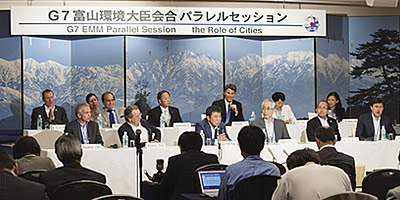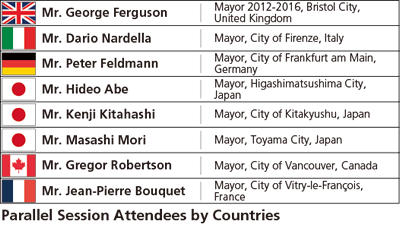Current Topics: G7 Toyama Environment Ministers' Meeting
Excursion
Blessed with good weather on both days, the excursions offered a great opportunity for the participants to fully enjoy the abundant nature and culture of Toyama
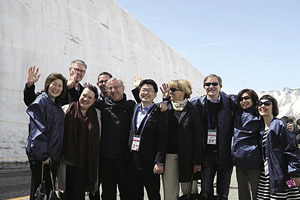
Visit to Tateyama "Yuki-no-Otani"
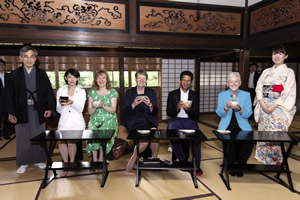
Tea Ceremony at a wealthy farmer's residence (Uchiyama Tei)
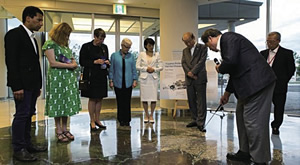
Visit to the Itai-itai Disease Museum
At the time of G7 Toyama Environment Ministers' Meeting, excursions were hosted by Toyama local committee (formed by Toyama prefecture, Toyama city and local businesses) on May 14, and by Ministry of the Environment of Japan on May 16. Blessed with good weather on both days, participants fully enjoyed abundant nature and culture of Toyama.
1. Excursion hosted by Toyama local committee on May 14
Toyama Prefecture features a remarkably dynamic landscape. Over just 40 kilometers in diameter, the Toyama Plain connects the 3,000 meter-high peaks of beautiful Tateyama Mountain Ranges to the 1,000-meter-deep Toyama Bay. The elevation difference is some 4,000 meters.
About 50 people including G7 meeting participants joined the excursion hosted by Toyama local committee (full-day tour). They first visited Tateyama Caldera Sabo Museum, where they listened to a lecture about co-existence with nature and effort to overcome flood damages. Then they experienced "Yuki-no-Otani" Snow Wall Walk and the national park in Tateyama, known for receiving heaviest snowfall in Japan. Half-day Tour participants visited Zuiryu-ji Temple (National Treasure), Kanaya-machi (Takaoka city) and Kaiomaru Park (Imizu city) and learned various historic and cultural legacies.
2. Excursion hosted by Ministry of the Environment of Japan on May 16
About 50 people including G7 meeting participants (accompanied by Ms. Tamayo Marukawa, the former Minister of the Environment of Japan) visited Uchiyama Residence, registered tangible cultural property and enjoyed the tea ceremony performed by Toyama Prefectural Tea Ceremony Association, Japanese cultural experience and interaction with the local residents.
After that, they visited the Itai-itai Disease Museum and were taken on a guided tour.
At reception parties held on May 14 and 15, the guests were served with delicious food, fresh from the sea and mountains, to their hearts' content.
More Information:
The Outcomes of Parallel Session on "the Role of Cities"
Urbanization has been rapidly developing worldwide in recent years. Cities face various challenges including environmental issues and they are increasingly expected to play a leading role in solving such problems through prompt and cross-sectoral decision making and efforts utilizing each of their own unique features. Against such backdrop, Parallel Session on "the Role of Cities" was held on May 15, 2016 in conjunction with the G7 Toyama Environment Ministers' Meeting.
Mayors of Toyama, Kitakyushu, Higashimatsushima, Bristol, Firenze, Frankfurt am Main, Vancouver and Vitry-le-François attended the session and had active discussions on the following three themes based on case examples introduced by those cities:
- Compact and resilient cities and modernization of transport network;
- Low-carbon and resilient energy supply systems using regional/local resources;
- Sharing of innovative approaches by selected leading city governments and promotion of city-to-city cooperation, roles of international organizations.
In the end, Co-Chairs wrapped up the discussion and integrated into Co-Chairs' Summary the following points as messages for the future:
- Recognizing, supporting and showcasing the advanced efforts by leading cities making the transition to sustainable societies;
- Promoting networks of leading cities and encouraging successive cities to be involved;
- Mainstreaming the role of cities.
Outline of the Summary was shared at the breakfast meeting among G7 Ministers the next day.




